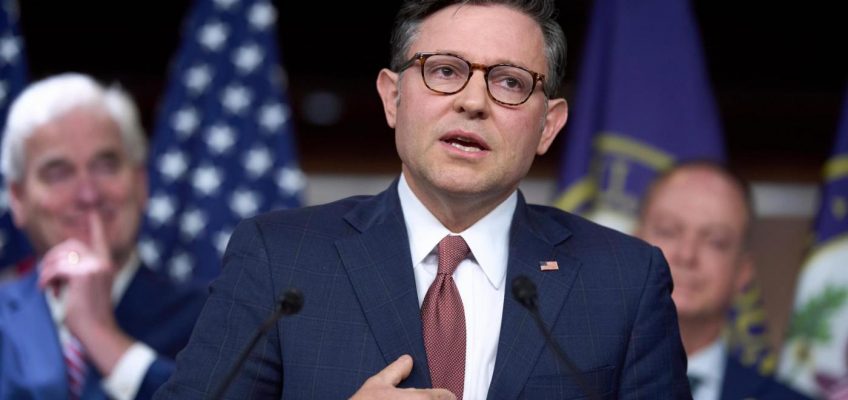For decades, politicians in both parties have operated on the belief that Social Security is the third rail of American politics, dangerous if not fatal to touch.
Since the 1990s, Medicare has seemed equally inviolate. The budget bill Republicans are hoping to bring to the Senate floor soon will test whether Medicaid and the Affordable Care Act now also belong on that list.
Republicans have long sought to repeal the Affordable Care Act, signed into law by President Barack Obama in 2010, and retrench Medicaid, a joint federal-state partnership created by the Great Society Congress in 1965 to provide health insurance to the poor.
In 2017, the Republican-controlled House of Representatives, with enthusiastic support from President Donald Trump, passed legislation that repealed the ACA and severely reduced funding for Medicaid. Although the Senate ultimately rejected a stripped-down version of that plan — with the late Senator John McCain dramatically dooming it with a thumb’s-down gesture on the Senate floor — the attempted repeal stoked a backlash that boosted the Democrats’ big House gains during the 2018 midterms.
In their new budget bill, congressional Republicans have taken one big lesson from that experience. The plan that passed the House last month, and the version advancing in the Senate, both avoid the head-on assault seen in the 2017 legislation. Instead, the GOP is applying a death-by-a-thousand cuts strategy that bleeds the ACA and Medicaid through a succession of less visible changes.
These include imposing a work requirement on able-bodied adults receiving Medicaid, restricting a financing technique that states have used to maximize federal Medicaid payments and adding new obstacles to buying insurance on the ACA exchanges. Among the legislation’s most consequential choices is a decision not to act: both bills let the enhanced subsidies for purchasing insurance on the ACA exchanges (approved by President Joe Biden and a Democratic Congress) expire as of Dec. 31.
Nothing on that list might seem as immediately threatening to voters as the central provisions of the 2017 repeal effort — particularly the earlier bill’s elimination of the ACA’s guarantee of insurance coverage for people with preexisting health conditions. Public polls show that the element of the GOP blueprint that is probably easiest to grasp — imposing work requirements on able-bodied adults receiving Medicaid — consistently draws majority support from voters when they first hear about it.
Yet cumulatively, the new bill comes much closer than is commonly understood toward matching the impact of the GOP’s 2017 repeal effort. The Brookings Institution recently calculated that when the cost of allowing the enhanced ACA subsidies to expire is included, the House bill would reduce federal health care spending by nearly as much as the 2017 package.
The Congressional Budget Office projects that provisions in this year’s House-passed bill would cause about 11 million Americans to lose health insurance. In addition, the CBO forecasts that allowing the enhanced ACA subsidies to expire (plus some other regulatory changes the administration is implementing) would cause another 5 million people to become uninsured, for a total coverage loss of 16 million. That is less than the CBO’s projections from the 2017 House bill (about 23 million), but still an astonishing number. If Trump signs the reconciliation plan into law, it would cause more Americans to lose health coverage than any single statute enacted in U.S. history, says Edwin Park, a research professor at Georgetown University’s Center for Children and Families.
Republicans have tried to target these cuts to minimize their political risk. The work requirement in both bills and the Senate’s limits on the “provider tax” financing technique would apply only to the 40 states that expanded Medicaid eligibility to more of the working poor through the ACA. The 10 states that have not expanded eligibility would not face any significant Medicaid reductions, and they almost all lean heavily red: Together, they elect about one-third of GOP members in both the House and Senate.
But that leaves plenty of other Republican-leaning constituencies vulnerable to these cuts. Medicaid is especially important to the health care systems in rural areas — which now vote overwhelmingly Republican — because fewer people in those places have employer-provided insurance. Polling by KFF, a nonpartisan health care thinktank, found that more adults who buy coverage on the ACA exchanges identify as Republicans than Democrats.
And previously unreleased KFF results provided to me found that adults without a four-year college degree, the cornerstone of the modern GOP coalition, comprise 85% of all Medicaid recipients. There are 64 House Republicans, as I’ve calculated with CNN colleagues, who represent districts where the share of Medicaid recipients exceeds the national average. And the states that would be hit hardest by the bills’ Medicaid cuts include solidly red Louisiana, Ohio, Indiana, and Missouri as well as the critical swing states of Michigan, Arizona and North Carolina.
All of those results reflect the new political geometry of health care: Since the passage of the ACA, federal health care programs have extended their reach up the income ladder even as Trump’s political strength among working-class voters has extended the GOP’s grasp down the income ladder. The GOP’s budget bill defiantly disregards that new alignment by stripping health coverage from millions of working- and middle-class Americans, and raising premiums for millions more while providing its biggest tax benefits to the wealthy — at a cost of nearly $4 trillion.
Republicans are barely questioning whether such a massive transfer of income from average to affluent families could endanger their electoral coalition. But the budget bill’s starkly contrasting priorities will likely test how far they can push the working-class voters who have become the party’s undisputed foundation in the Trump era.
Ronald Brownstein is a Bloomberg Opinion columnist covering politics and policy. He is also a CNN analyst and previously worked for The Atlantic, The National Journal and the Los Angeles Times. He has won multiple professional awards and is the author or editor of seven books.
Related Articles
Llewellyn King: DOGE kids’ crude cuts to research undermine American strength
Gautam Mukunda: How AI and charter schools could close the tutoring gap
Laura Thornton: Dispelling Russia’s myths about Ukraine
Thomas Friedman: If this Mideast war is over, get ready for some interesting politics
Freilich, Clarke: Tehran has only bad options. Trump and Netanyahu have golden opportunities




